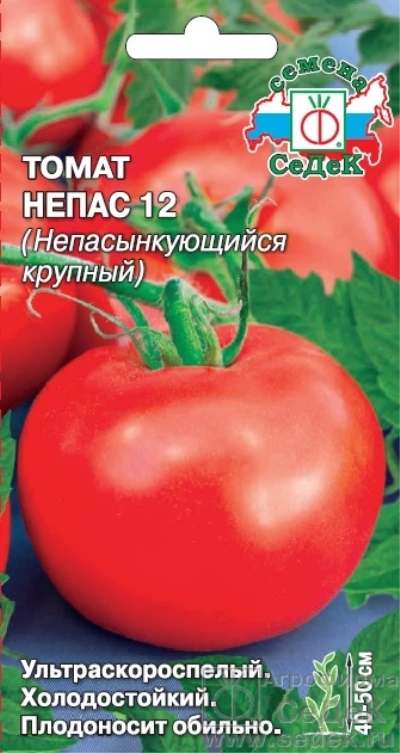
- Authors: Lukyanenko A.N., Dubinin S.V., Dubinina I.N.
- Year of approval: 2018
- Category: grade
- Growth type: determinant
- Appointment: fresh consumption
- Ripening period: early
- Ripening time, days: 95-100
- Growing conditions: for open ground, for film greenhouses
- Bush height, cm: 40-50
- Leaves: medium length, dark green
Tomato Nepas 12 is one of those options that has good resistance to cold, so it is not scary to transplant it into open ground in early spring in the form of seedlings.
Description of the variety
This is a plant with limited growth, the fruits of which are not suitable for conservation, but very tasty when fresh. The maximum up to which a tomato can grow is 50 cm. This is a standard plant with dark green foliage.
The main qualities of the fruit
Ripe fruits of Nepas 12 are red. Their maximum weight is 140 grams. The pulp can be characterized as medium density.
Taste characteristics
Tomato Nepas 12 has a pleasant tomato flavor.
Ripening and fruiting
It is an early variety that ripens in 95-100 days.
Yield
If a tomato of the described variety is grown in a greenhouse, then its yield is 6.3 kg / sq. m.
The timing of planting seedlings and planting in the ground
In May, you can transplant plants into open ground, seedlings begin to sow seeds in March-April.

Growing tomato seedlings is an extremely important process, because it largely depends on whether the gardener will be able to harvest at all. All aspects must be taken into account, from seedbed preparation to planting in the ground.
Landing scheme
The standard scheme of 40 * 60 cm has proven itself quite well.

Growing and care
Nepas 12 is one of those varieties that do not require pinching and shaping.
Experienced gardeners begin to plant seeds in the first decade of March. If you use seeds from your tomatoes, they need to be dipped in a warm solution of potassium permanganate, it is advisable to select for further planting only those that have sunk to the bottom of the container for 10 minutes.
The seed is then washed and kept wrapped in a damp cloth for several days. As soon as sprouts begin to appear, the seeds are "hardened": 2-3 times they are placed in the refrigerator for 12 hours.
The best option would be to use purchased ready-made soil. It is allowed to use land from your site, which has been prepared in the fall. Ash, compost are added to it, poured with potassium permanganate.
Seeds are planted in boxes with prepared soil or in separate cups. If the seedlings will not stand on a sunny window, you will have to use fluorescent lamps. After planting the seeds, the boxes are covered with glass or transparent film. Seedlings should appear within a week.
Water the Nepas 12 seedlings as needed, feed them with complex fertilizers after the first true leaves appear.
If the tomatoes are planted in a common box, then after the appearance of the first 3 leaves, they are dived, planted in separate cups.2 weeks after the pick, they are fed a second time.
It is better to plant Nepas 12 tomatoes in the greenhouse in the late afternoon, so that they do not immediately appear in the bright sun. The distance between the plants should be at least 40 cm. Hardened tomatoes will tolerate transplanting better - if before that they were taken outside for several hours every day.
The planting time of Nepas 12 seedlings depends on which greenhouse is used. A heated room is ready to receive tomatoes at the end of April, an unheated one - from mid-May. The air temperature inside the greenhouse should be around + 25 ° C.
Landing in open ground by the end of May in the southern regions, a little later - in the middle lane.
After planting, the tomatoes are watered abundantly. The procedure should be carried out 1 time in 3-4 days. If there are a lot of tomatoes, it is more convenient to use the automatic system. Ideally, drip irrigation. But it is undesirable to pour water from a hose. Chlorinated water that has not been settled is not very good for Nepas 12, and the jet will break the ground around the tomatoes, exposing the root system. You need to pour water at the root, if the drops hit the leaves, they can be burned by sunlight.
Fertilizer after planting seedlings Nepas 12 is applied twice. The first time - when young tomatoes were moved to a new place, the second time - when the ovary appeared.
You can use ammonium and calcium nitrate, or buy fertilizer in liquid form, dilute it in water and water the bushes.
The lower leaves should be trimmed as the tomatoes grow, but be careful not to damage the stem.
It so happens that Nepas 12 tomatoes bloom, but there is no ovary. This is the so-called fattening. Tomatoes are pleasing in appearance - strong stems, leaves of a rich color, but a weak flower brush. The reason is an excess of fertilizers, for example, nitrogen fertilization. In this case, you will need to flush the nitrogen with abundant watering (8-10 liters under the bush) or carry out potassium dressing using potassium sulfate (1.5-2 g per plant).




A plant needs different micronutrients at each stage of growth. All fertilizers can be divided into two groups: mineral and organic. Folk remedies are often used: iodine, yeast, bird droppings, eggshells.
It is important to observe the rate and period of feeding. This also applies to folk remedies and organic fertilizers.


Resistant to adverse weather conditions
Tomato Nepas 12 demonstrates cold hardiness.
Growing regions
As a greenhouse variety, it is suitable for growing in any region of the country.

























































































